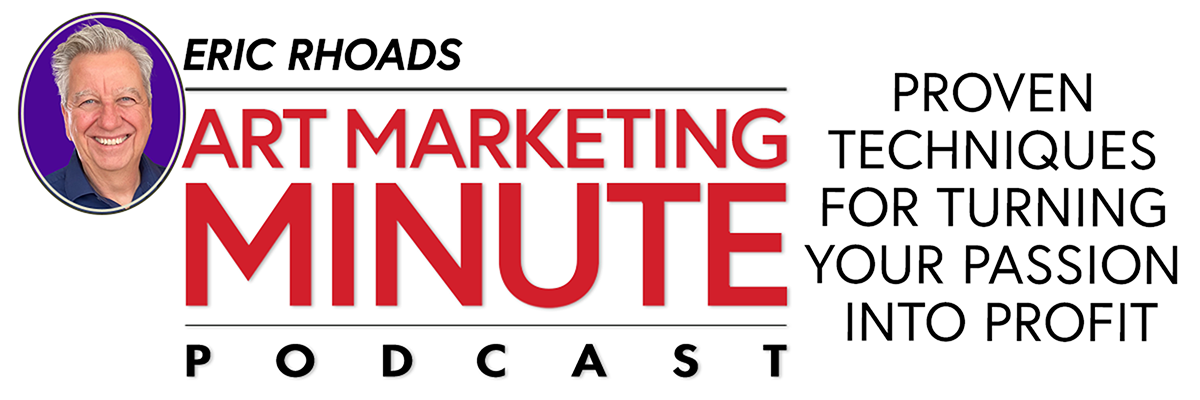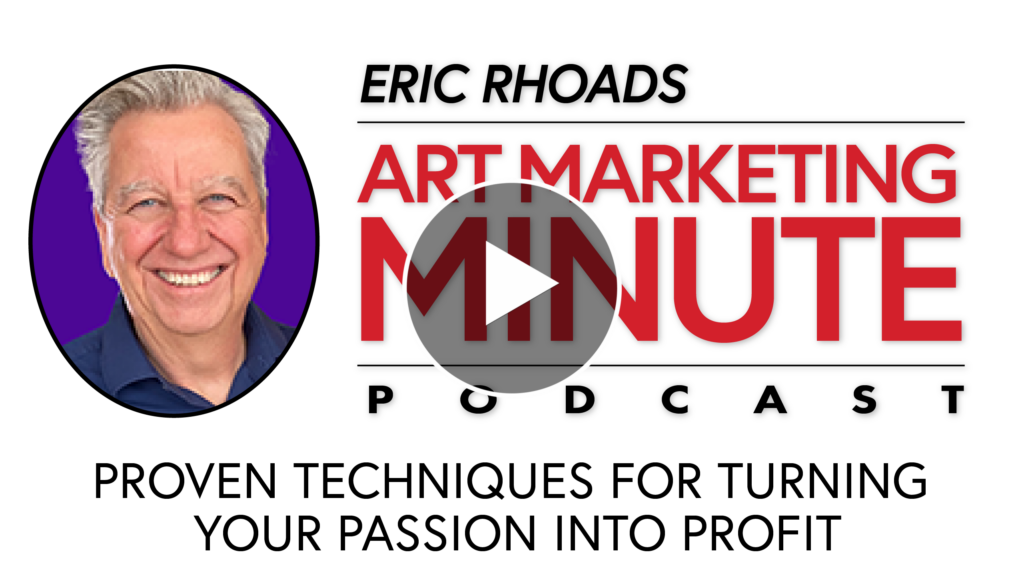In the Art Marketing Minute Podcast, you’ll learn how to sell your art, how to market your paintings, and everything else you need to know in order to have a successful art career. Each episode answers questions from artists by host Eric Rhoads, author of “Make More Money Selling Your Art,” publisher of several art magazines and newsletters, and author of ArtMarketing.com.
Does your art website or newsletter need a catchy title? Are there any traps that artists can be aware of and avoid? Eric Rhoads answers in this week’s Art Marketing Minute Podcast.
Listen to the Art Marketing Minute Podcast: Episode 74 >
Submit Your Art Marketing Question:
What questions do you have about selling your art? Email Eric today at [email protected] (include your name and where you’re from) to hear your question answered on an upcoming Art Marketing Minute Podcast.
FULL TRANSCRIPT of the Art Marketing Minute:
DISCLAIMER: The following is the output of a transcription from an audio recording of the Art Marketing Minute. Although the transcription is mostly correct, in some cases it is slightly inaccurate due to the recording and/or software transcription.
Announcer:
This is the Art Marketing Minute with Eric Rhoads, author of the Amazon best selling book, “Make More Money Selling Your Art.” In the marketing minute we answer your questions to help your art career brought to you by artmarketing.com, the place to go to learn more about marketing. Now, here’s your host, arts magazine publisher, Eric Rhoads.
Eric Rhoads:
In the marketing minute I answer your art marketing questions yours can become part of the broadcast if you email me, [email protected]. We also have our own art Marketing Podcast. It’s the same content that we just push out as a separate podcast. And so if you don’t want to listen to plein air podcast, which you want the marketing, you can just go there. Now here’s a question from John O’Neill in Albany, New York who says I’m finally ready to start a website and a newsletter. My question is, does it need a catchy title or something that’s more direct? Like my name? Well, John, I think you know, in my book, make more money selling your art or whole a whole thing on websites. And that’s something you want to check out. But first off, everybody says, Well, I have to have a website, well, the web is changing, and things are changing a lot. Now, the question is, before you even create a website, you have to ask yourself, what’s my strategy? Why am I creating a website? What do I have? What do I hope to have happen with that website? Is my website, a branding tool, a way to show my artwork? Is it a way to sell my artwork? Is it all of the above? What is the 80%? Or what is the one thing that you really want to focus on and try to figure that out before you decide if you’re going to start a website, because, quite frankly, nowadays, you can kind of do almost the same thing with Facebook and Instagram. And there’s also a lot of other things that are trending. So you may want to ask yourself, Is this really necessary anymore? Now, there’s a lot of people out there that make great websites, and you know, you can kind of make your own through them. And some of them are art specific, and some of them are not, you’re going to have to decide what works for you. But do you need a catchy title or something that’s more direct? Well, catchy titles can be risky. You know, if you were, remember Thomas Kincade, the painter of light I mean, that was a catchy title. And but yeah, and then for a long time, everybody was, the painter of this and the painter of that, but I’m not so sure it really meant anything. You know, what you’ve got to do is figure out what is the focus on what do I really want to spend my time doing? The big mistake that I think artists make when they’re trying to market themselves, they try to be too many things to too many people, they try to do too many styles or they try to do too many subject matter. Figure out first what it is you want. So if you are going to be a catchy title, or if you’re maybe it doesn’t even have to be catchy. It might just be you know, John O’Neill, landscape painter, it might be john O’Neill, ocean painter, seaside painter, or whatever it is, you’re good at, you know something because we can’t all be good at everything and you want to kind of get known for something. So first thing I think is, put your name up there, John O’Neill and then then if you want to say I have a subhead, that is kind of an explainer, you know, a subhead explainer is like Coca Cola and then it’s is the real thing, right? So I don’t know if that means anything anymore. But it did it maybe at one time. So you got to think about that. But no, your name is fine. And people are going to Google your name and you want them to find you. And this is an opportunity to brand yourself. Now one mistake I think a lot of people make is they love they fall in love with their signature, and they put this big, unreadable signature at the top of their website. Now, that’s okay. That’s okay. If you also put your name on top of it in text that somebody can read. But a lot of people can’t read that stuff. Everybody thinks they can. And you know, there’s nothing worse than a signature that nobody could read, at least put your name on the back of the painting, too. We’ll have a whole nother thing on the back of the painting sometime. Anyway. Hope that helps.
Here’s a question from Jeffrey Skelton in Nashville, Tennessee, who says I’m always hearing about new scams. Are there any traps that artists can be aware of and avoid? Well, Jeffrey, I’m not the guy. You know, this is a marketing podcast. But let me just tell you what I know. And I don’t know much. But I have been approached many times. from someone, it’s always a different name. It’s always a different email. But the email goes something like this. I was looking at your website, I’m trying to find something really special for my wife for her birthday, or anniversary, you know, some particular thing. And I found a particular painting, I’d like to buy it from you. Can we make arrangements? And so here’s how the scam I’m told works. And that is that, you know, they they say they want to send you a check. And then you send them the painting, and then the check doesn’t clear. So first off, if they’re saying those words, chances are it’s a scam. But secondly, you know, you can hammer the cheque, you can go to the bank, and you can say, I’m not going to send this until the check clears. Now one of the other things they do is, they overpay. So let’s say your painting is $1,000 they send you a 15 $100. And then they sent you know, they send the check and then they overpay and then there’s some way that they cancel the check and they manipulate it or something. And as a result, they’re getting $500 cash out of that transaction when they had no intent of paying. If you want to read up on art scams, I would probably check out I think the FBI has an art scamming division. You might want to check that out. But you know, something sounds too good to be true. It is it always is. So just keep that in mind.
Well, this has been the art marketing minute with me. Eric Rhoads. My goal in life is to eliminate the idea of starving artists to help your dreams actually come true. So if you want to submit questions, simply email [email protected]. And to learn more about marketing ideas, you can visit Artmarketing.com. Thanks for listening.
How to Submit Your Art Marketing Questions: What questions do you have about selling your art? Email Eric today at [email protected] (include your name and where you’re from) to hear your question answered on an upcoming Art Marketing Minute Podcast.



Leave A Comment